Royal Canadian Army Cadets
| Royal Canadian Army Cadets | |
|---|---|
|
Royal Canadian Army Cadets badge. | |
| Active | July 25, 1879 – present |
| Country | Canada |
| Type | Youth Organization |
| Size | ~20,000 Army Cadets supported by |
| Part of | Canadian Cadet Organization |
| Headquarters | Ottawa, Canada |
| Motto(s) | Acer Acerpori (As the Maple, so the Sapling) |
| March | Quick: "Cadet" |
| Commanders | |
| Colonel-in-Chief | HRH Prince Philip, Duke of Edinburgh[1] |
| Colonel Commandant | Brigadier-General (Retired) R.R. Romses, OMM, CD |
The Royal Canadian Army Cadets (RCAC) is a Canadian national youth program sponsored by the Canadian Forces and the civilian Army Cadet League of Canada. Under the authority of the National Defence Act the program is administered by the Canadian Forces and funded through the Department of National Defence. The civilian partner provides support in the local community. Many Army Cadet corps receive additional support from affiliated Regular or Reserve Army units. While cadets may wear the badges and accoutrements of their affiliated unit, cadets are civilians, they are not members of the Canadian Forces .[2]
Recognized as Canada's oldest youth program, there are approximately 21,000 army cadets in about 450 corps across the country. Together with the Royal Canadian Sea Cadets and Royal Canadian Air Cadets, it forms the largest federally funded youth program. Cadets are encouraged to become active, responsible members of their communities.
Basics
Along with the Royal Canadian Sea Cadets and Royal Canadian Air Cadets, the RCAC is part of the Canadian Cadet Organization. The RCAC and the other cadet programs is led and financed by the Canadian Forces. The program is run in partnership with the Civilian Army Cadet League of Canada that provides supervision of the local corps squadron sponsor that supports the program at the community level by providing support not provided by the Canadian Forces. Cadets are not members of the Forces, and there is no expectation to join the Canadian Forces. In keeping with Commonwealth custom, the Royal Canadian Army Cadets stand second in the order of precedence, after the Royal Canadian Sea Cadets, and before the Royal Canadian Air Cadets.
People aged 12 to 18 may join the RCAC, free of charge. Uniforms, training manuals, and instruction are provided. A cadet must leave the organization before their 19th birthday. Upon departing, most items issued to them during their time in the program must be returned. Some cadet corps conduct a "leaving ceremony", to recognize departing cadets. If the senior-ranked cadet is departing he or she will relinquish the senior position by passing on the drill cane, or the Corps flag to his or her successor.
The organization and rank system of the Canadian Army is used. Cadets are appointed to Non-Commissioned Member ranks and take seniority amongst themselves. A few large school sponsored cadet corps use cadet officer designations from Lieutenant to Lieutenant Colonel a practice that is not officially recognized. Army Cadet Corps are often affiliated to a Reserve or Regular Force army regiment and wear the accouterments of their affiliated unit. Adult leadership is provided by members of the Canadian Forces Reserve Sub component Cadet Organization Administration and Training Service composed mostly of officers of the Cadet Instructor Cadre (CIC) Branch, supplemented, if necessary, by contracted Civilian Instructors, authorized adult volunteers, and, on occasion, officers and non-commissioned members of other CF branches. The CIC Branch is specifically trained to deliver the Royal Canadian Sea, Army, and Air Cadet training program, and like all reservists come from all walks of life and all parts of the community. Some are former cadets, many have former regular or reserve force service.
RCAC Badge
The Royal Canadian Army Cadet Badge is the official emblem of RCAC. It is worn on the upper sleeve of the cadet uniform and on the breast of the issue parkas. It is also worn as a brass or cloth cap badge in place of an affiliated unit badge or for non-affiliated corps. The term Acer Acerpori is Latin for "as the maple, so the sapling."
Aim
The aim of Royal Canadian Army Cadets is "To develop in youth the attributes of good citizenship and leadership; promote physical fitness; and stimulate the interest of youth in the sea, land, and air activities of the Canadian Forces. The RCAC shares this aim with the Sea and Air Cadets; however, each focuses on its own parent element.
History
Early history
The Royal Canadian Army Cadets (RCAC) can trace its history to the creation of drill associations or militia companies in 1861, pre-dating confederation by six years. These early militia companies and drill associations were not cadet corps but were militia sub-units formed in educational and other public institutions. Enrollment was limited to men between the ages of 13 and 60. The drill was not only a parade square and discipline exercise, but a skill that was necessary for the defence of the Colony. The American Civil War and the threat of the Fenian Raids motivated their creation in Upper and Lower Canada.
Trinity College Volunteer Rifle Company was formed June 1, 1861 in Port Hope, Ontario. Bishop’s College Drill Association was formed in Lennoxville, Que. on December 6, 1861. Another 14 of the early "Drill Associations" or "Rifle Companies" stood up in Ontario and Quebec. Canada's oldest continuously active cadet corps is No. 2 Bishop's College School Cadet Corps in Lennoxville, Quebec (Nov 1879), and No. 7 Royal Canadian Army Cadets in St. Thomas, Ontario (Feb 1880) both have roots firmly in the previous drill associations.
In 1904 the allocation of numbers to cadet corps was instituted and the Quarterly Militia List, correct to April 1, 1904 lists Cadet Organizations from 1 to 104. The earliest date of organization shown is November 28, 1879 four months after Militia General Order 18 of July 25, 1879 allowed the formations of 74 "Associations for Drill in Educational Institutions" for young men. These cadets were taught drill and marksmanship, but were not required to be employed in active service. The 74 associations included 34 in Ontario, 24 in Québec, 13 in the Maritimes, two in Manitoba, and one in British Columbia.
The origin of the term "Cadet Corps" is debatable, as some believe it was first used in 1898, in Ontario, bundled in a provision that the Corps' instructors would be a member of the local school teaching staff, and not from the local militia unit.
Public support
Increased support, motivated in part by the Northwest Campaign during the Riel Rebellion of 1885, allowed improved issue of uniforms, weapons and other equipment to schools providing military training.
Cadet Instructor Cadre
The first authority for Cadet instructors to hold rank in the Militia was established by Special General Order Dec. 21, 1903. The appointment was 2nd Lieutenant and the officer was permitted to retain the rank only as long as he remained an instructor and the cadet corps remained efficient. On May 1, 1909 a cadre of commissioned officers, as a Corps of School Cadet Instructors was established. It was composed of qualified male school teachers. On May 1, 1921 the Corps was reorganized on Jan 1, 1924 and designated the Cadet Services of Canada. It was a component of the Canadian Army Non-Permanent Active Militia and the forerunner of the current Cadet Instructor Cadre. With the integration of the Canadian Forces in 1968, the officer cadre was designated as the Cadet Instructors List a sub-component of the Canadian Forces Reserve. In July 1994 it was renamed Cadet Instructor Cadre. In 2009 the reserve sub-component was renamed the Cadet Organization Administration and Training Service. It consists of the CIC Branch and other reserve officers and non-commissioned members.
Strathcona Trust
In 1910, Sir Donald Alexander Smith, Lord Strathcona, the Canadian High Commissioner to Britain, created a trust with the Dominion Government with a sum of $500,000, with the aim of inspiring citizenship and patriotism. through physical training, rifle shooting, and military drill.[3] He is remembered today with the Lord Strathcona Medal, which is awarded to a cadet in each corps and squadron who best exemplifies the qualities of being a cadet.
World Wars
Approximately 40,000 former cadets served in His Majesty's forces during the First World War. By the end of the war, there were approximately 64,000 boys enrolled in Army Cadet corps across Canada.
During the twenty years following the First World War, cadet training came to a standstill. Many corps survived these hard times, but the Depression and the lack of public interest caused the cancellation of the uniform grant for Army Cadets in 1931 and the instructional grant for 12- and 13-year-olds in 1934. In Alberta, only a couple of corps functioned beyond 1934.
The beginning of the Second World War brought a renewed public interest in cadet training. An astounding amount of cadet corps were formed in high schools across the country.
Post-war years
In 1942, recognition of the significant contribution of former cadets to the ongoing war effort, His Majesty King George VI granted the "Royal" prefix to the Canadian Army Cadets, giving it the title of the Royal Canadian Army Cadets. (The Royal prefix was also afforded Sea and Air Cadets at the same time) It is estimated that nearly 230,000 former army cadets served in His Majesty's forces during the Second World War.
After 1945, quotas were imposed reducing Canada's total cadet population to about 75,000 members. Many of the closed corps, those with membership restricted to boys in one particular school, were disbanded; some of them became open corps, training in militia armouries or in Legion halls; others, acquired their own buildings.
The Korean War stimulated growth among open corps in the early 1950s. Many school corps moved to armouries and drill halls. After 1954, Korea veterans staffed the Area Cadet Offices that began to manage these corps and the summer camps that trained them.
Unification of the Canadian Forces
Following the unification of the Canadian Forces in 1968, a number of changes occurred in the Army Cadet world:
- QR&O (Cadets) brought Sea and Air Cadet Officers under the single service control of the Canadian Forces and standardized the three Cadet Organizations;
- A directorate of cadets was established in Ottawa, at National Defence Headquarters, to set policy and co-ordinate the activities of the Sea, Army and Air Cadet Organizations;
- The Army Cadet League of Canada was formed in 1971 to provide the Army Cadet Organization the same civilian/CF partnership structure enjoyed by Sea Cadets and Air Cadets through the long established Navy League and the Air Cadet League;
- Officers of the Cadet Services of Canada, The Royal Canadian Sea Cadets and former RCAF Air Reserve Cadet Instructors were consolidated in the Cadet Instructor List, which was redesignated the Cadet Instructor Cadre in July 1994.
- The Army Cadet League's Arms, Supporters, Flag and Badge were registered with the Canadian Heraldic Authority on March 31, 1995[4]
Girls in the cadet program
Girls were unofficial participants in cadet training almost from the very beginning of Cadets. Shortly after the Highland Cadet Corps was formed at the Guelph Grammar School in 1882, a female cadet company called the Daughters of the Regiment was started. The Army provided no support for training, or uniforms. Nor could girls attend summer training.
On July 30, 1975, the Canadian parliament amended the relevant legislation by changing the word "boys" to "persons", therefore permitting girls to become members of the Royal Canadian Army Cadets. Girls became full participants in the Cadet Organization. The biggest change was during the summer training program. What had been for many decades an exclusively male environment changed dramatically at local corps and at Army Cadet Summer Training Centres. Today, boys and girls participate equally in all cadet activities.
2004 – 125th anniversary
2004 marked the 125th anniversary of the Royal Canadian Army Cadets. The Army Cadet League of Canada issued a 125th Anniversary pin to be worn by all 25,000+ army cadets across the country. Canada Post honoured the cadets with a stamp, unveiled in Ottawa in March 2004. Many parades honouring the century and a quarter of cadets occurred across Canada, there were Freedom of the City parades in Vernon, Oromocto and Calgary as well as other locations. The original Royal Banner was laid up in Vernon during the final battalion parade on August 19 at the ACSTC, and the new Royal Banner was paraded in front of 1500 cadets and 2000 members of the audience.[5]
RCAC Training
Optional Training
In the cadet program there are several optional training programs that like:
- Military Band and Pipes Band
- Marksmanship
- Biathlon
- First Aid Program
- Drill Team
- Orienteering
These Optional Programs are extensions of the normal training you in the cadet corps
Star Level Program
The Star Level Program is the main training program carried out by all Royal Canadian Army Cadet Corps in Canada. This program is mandated by the Department of National Defence, through the Directorate of Cadets & Junior Rangers.
The Star Level Program is composed of five levels:
- Green Star (Level 1)
- Red Star (Level 2)
- Silver Star (Level 3)
- Gold Star (Level 4)
- Master Cadet (Level 5)(New)
Starting in the 2012-13 training year, the National Star of Excellence or NSE replaced the National Star Certification Examination or NSCE as a ranking tool for Senior Cadets. Year 5 of LHQ training was also introduced as "Master Cadet" consisting of a great deal of OJT and self-led professional development opportunities.
Cadets are taught a variety of subjects, known as Performance Objectives (PO) that include: citizenship, physical fitness, healthy living, drill, marksmanship, map and compass, outdoor survival, eco-friendly camping and military history and traditions. To better assist in understanding the Star Level training, the Star programs are identified as follows:
Green Star
- PO 101—Participate in Citizenship Activities: Cadets are introduced to Canadian history, traditions and symbols. Cadets are also introduced to Canada’s political system, along with a high-education of the Canadian Forces.
- PO 102 – Perform Community Service: Cadets are introduced to the concept of volunteerism and importance of community involvement.
- PO 103 – Participate as a Member of a Team: Cadets are introduced to the concept of teamwork and are introduced to the roles of a follower.
- PO 104 – Develop a Personal Activity Plan: Cadets are introduced to the importance of physical activity, physical fitness and physical health.
- PO 105 – Participate in Recreational Sports: Cadets participate in a variety of recreational sports, such as running, biking, hiking, marches and swimming activities.
- PO 106 – Fire the Cadet Air Rifle Marksmanship
- PO 107 – Serve in an Army Cadet Corps: Cadets are introduced to the history and traditions of the Cadet Corps. Cadets are introduced to Green Star and Year 1 training opportunities. Cadets are taught the basic rules with regards to being a cadet.
- PO 108 – Participate in an Annual Ceremonial Review (ACR) Parade: Cadets are introduced and taught ceremonial drill, in preparation for public parades.
- PO 109 – Participate in Fieldcraft
- PO 120 – Demonstrate Knowledge of the Organization and Traditions of the Canadian Forces:
- PO 121 – Participate as a Member of a Group During a Weekend Bivouac Exercise:
- PO 122 – Identify Location Using a Map:
- PO 123 – Participating in a Day Hike:
Red Star
- PO 201 – Identify the Role of an Environmentally Conscious Canadian Citizen:
- PO 202 – Perform Community Services:
- PO 203 – Demonstrate Leadership Attributes Within a Peer Setting:
- PO 204 – Update Personal Activity Plan:
- PO 205 – Participate in Recreational Sports:
- PO 206 – Fire the Cadet Air Cadet Rifle During Recreational marksmanship:
- PO 207 – Serve in an Army Cadet Corps:
- PO 208 – Execute Drill as a Member of a Squad:
- PO 211 – Participate in Competitive Summer Biathlon Activities:
- PO 220 – Recognize Canadian Forces Peace Support Operations:
- PO 221 – Perform the Duties of a Section Member During a Weekend Bivouac Exercise:
- PO 222 – Navigate Along a Route Using a Map and Compass:
- PO 223 – Hike along a Route as Part of an Overnight Exercise:
- PO 224 – Identify Immediate Actions to Take when Lost:
Silver Star
- PO 301 – Recognize the Purpose of Service Groups within Canada:
- PO 302 – Perform Community Service:
- PO 303 – Perform the Role of a Team Leader:
- PO 304 – Update Personal Activity Plan:
- PO 305 – Participate in Recreational Sports:
- PO 306 – Fire the Cadet Air Rifle During Recreational Marksmanship:
- PO 307 – Serve in an Army Cadet Corps:
- PO 308 – Direct a Squad Prior to A Parade:
- PO 309 – Instruct a Lesson:
- PO 311 – Participate in a Recreational Summer Biathlon Activity:
- PO 320 – Recognize the Valour of Members of the Canadian Army:
- PO 321 – Perform the Duties of a Team Leader On A Weekend Bivouac Exercise:
- PO 322 – Plot Location on a Topographical Map Using A Global Positioning System Receiver:
- PO 324 – Survive When Lost:
- PO 325 – Identify the Competencies of an Outdoor Leader:
- PO 326 – Perform Expedition Skills:
Gold Star
- PO 401 - Recognize How the Legal System Affects Youth:
- PO 402 - Perform Community Service:
- PO 403 - Act as a Team Leader:
- PO 404 - Update personal Activity Plan:
- PO 405 - Participate in Recreational Sports:
- PO 406 - Fire the Cadet Air Rifle During Recreational Marksmanship:
- PO 407 - Serve in an Army Cadet Corps:
- PO 408 - Command a Platoon on Parade:
- PO 409 - Instruct a Lesson:
- PO 420 - Identify the Structure of the Canadian Army:
- PO 422 - Follow a Multi-Leg Route Using a Global Positioning System (GPS) Receiver:
- PO 424 - Employ Natural Resources in a Survival:
- PO 425 - Develop an Expedition Plan:
- Section 1 - Establish Expedition parameters:
- Section 2 - Plan an Expedition Route:
- Section 3 - Develop an Expedition Equipment List:
- Section 4 - Develop an Expedition Ration Plan:
- Section 5 - Discuss Actions Taken when a Person is Lost:
- Section 6 - Analyze Problems Using an Expedition Case Study:
- PO 426 - Perform Expedition Skills:
Master Cadet
The Master Cadet star level is the highest star level.
Summer training
Selected Army Cadets attend summer training at locations across Canada. The training supports and expands the Local Headquarters program. Courses last from two to eleven weeks, with most cadets attending the two-week "General Training" (Commonly referred to as "GT", as Basic is now a new section of three-week courses) Course in their first year. Experienced cadets may apply to be employed as staff cadets to assist the adult instructors.
Summer Training Courses
Summer Training Courses are as follows:
- General Training (2 Weeks)
- Basic Expedition (3 weeks)
- Basic Drill & Ceremonial (3 weeks)
- Basic Fitness & Sports (3 Weeks)
- Basic Marksman (3 Weeks)
- Basic Military Band (3 Weeks)
- Basic Pipes and Drums (P&D) (3 Weeks)
- Fullbore Marksman Phase I (6 Weeks) (Connaught CTC Only)
- Intermediate Military Band (6 Weeks)
- Intermediate Pipes and Drums (P&D) (6 Weeks)
- Expedition Instructor (EI) (6 Weeks)
- Drill and Ceremonial Instructor (DCI) (6 Weeks)
- Fullbore Marksman Phase II (7 Weeks) (Connaught CTC Only)
- Fitness and Sports Instructor (FSI) (6 Weeks)
- Air Rifle Marksmanship Instructor (ARMI) (6 Weeks)
Once a cadet has completed an Instructor-level course he or she may apply for advanced the training to be appointed as a staff cadet at a cadet training centre (CTC) or engage in the advanced training course or exchange, such as:
- Advanced Military Band (6 Weeks)
- Advanced Pipes and Drums (P&D) (6 Weeks)
- Leadership & Challenge
- Outward Bound: Wales/Scotland
- Canadian Forces Basic Parachutist Course
- Maple Leaf Exchange
- National Rifle Team 9 Weeks (Bisley)
- Army Cadet History Tour
Cadet Training Centres
Army Cadets trained at various locations across Canada including:
- Blackdown Cadet Training Centre (Blackdown CTC)
- Argonaut Cadet Training Centre (Argonaut CTC
- Cold Lake Cadet Training Centre (Cold Lake CTC)
- Connaught Training Centre (Connaught CTC)
- Mont St-Sacrement Cadet Music Training Centre (Mont St-Sacrement CMTC)
- Rocky Mountain Training Centre (Rocky Mountain CTC)
- Valcartier Training Centre (Valcartier CTC)
- Vernon Training Centre (Vernon CTC)
- Whitehorse Cadet Training Centre (Whitehorse CTC)
Rank Structure
| Senior ranks (Rangs supérieurs) | ||
|---|---|---|
.svg.png) Cadet Chief Warrant Officer (C/CWO) |
A simplified version of the 1957 Coat of Arms of Canada. | |
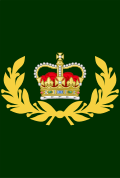 Cadet Master Warrant Officer (C/MWO) |
St. Edward's Crown within a laurel wreath. | |
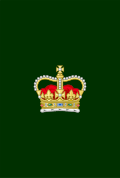 Cadet Warrant Officer (C/WO) |
St. Edward's Crown. | |
 Cadet Sergeant (C/Sgt) |
Three chevrons surmounted by a maple leaf | |
| Junior ranks (Rangs subalternes) | ||
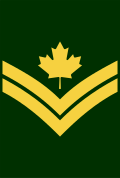 Cadet Master Corporal (C/MCpl) |
Two chevrons surmounted by a maple leaf. | |
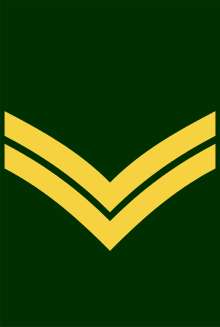 Cadet Corporal (C/Cpl) |
Two chevrons. | |
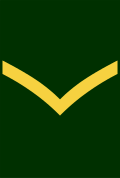 Cadet Lance Corporal (C/LCpl) |
One chevron. | |
.svg.png) Cadet (Cdt) |
No insignia. | |
Note: The second rank of Lance Corporal, formerly "Private", was changed in January 2010, due to the French translation "Soldat" being the word "soldier". If a Cadets Corps has an affiliation with a Unit of the CF that traditionally has a different word for the Rank of "Private", they are then entitled to make use of that alternative title. Thus, Corps affiliated with the Royal Canadian Artillery would use "Gunner" (Also the term Bombardier & Master Bombardier could substitute for Corporal & Master Corporal)
- Rifle Regiments - Rifleman
- Highland (Scottish) Regiments - Highlander
- Combat Engineer Regiments - Sapper
- Armoured (Cavalry) Regiments - Trooper
- Signals (Communications)Regiments - Signalman
- Artillery Regiments - Gunner
N.B.: The above list may not be comprehensive, nor does it address French nomenclatures.
References
- ↑ http://www.armycadethistory.com/colonels_in_chief.htm
- ↑ http://www.armycadetleague.ca/Templates/faqcadete.html
- ↑ http://www.cadets.ca/_docs/army-arm%E9e/pocket-poche/A-CR-CCP-120-402_e.pdf
- ↑ http://archive.gg.ca/heraldry/pub-reg/project.asp?lang=e&ProjectID=526 Arms, Supporters, Flag and Badge
- ↑ http://www.armycadethistory.com/
External links
- Official site
- RCAC Unit Directory
- Army Cadet League of Canada
- Royal Canadian Army Cadets History – Army Cadet League of Canada
